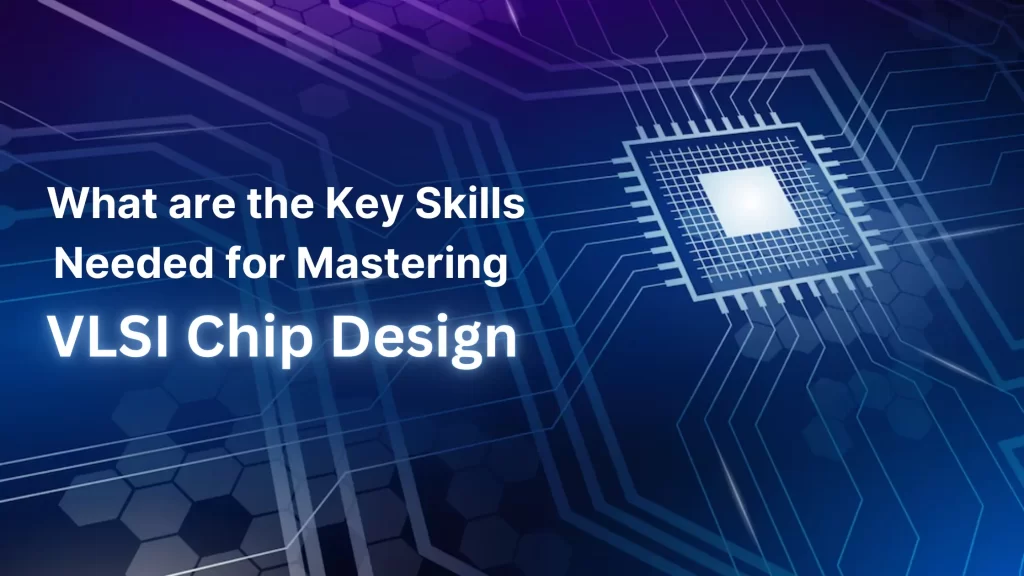
VLSI chip design (Very Large Scale Integration) is a specialized field in electronics and electrical engineering that involves creating complex integrated circuits by combining thousands of transistors into a single chip. Mastering VLSI chip design requires a blend of theoretical knowledge and practical skills. This article outlines the key skills needed to excel in VLSI chip design.
1. Electronics & Electrical Engineering Foundation
Understanding Basic Concepts
A strong foundation in the basic concepts of electronics and electrical engineering is essential for VLSI chip design. This includes knowledge of digital and analog circuits, semiconductor devices, and circuit theory. Understanding how transistors work, how to design circuits, and how to analyze circuit behavior is crucial.
Circuit Design and Analysis
Proficiency in circuit design and analysis is another critical skill. This involves designing circuits that meet specific performance criteria, such as speed, power consumption, and reliability. Being able to analyze circuits using tools like SPICE (Simulation Program with Integrated Circuit Emphasis) is also important.
2. Proficiency in Hardware Description Languages (HDLs)
VHDL and Verilog
VHDL (VHSIC Hardware Description Language) and Verilog are the two primary hardware description languages used in VLSI chip design. Mastery of these languages is essential for designing and describing the behavior of electronic systems. These languages allow designers to model the functionality of digital circuits and simulate their behavior before physical implementation.
Simulation and Synthesis
In addition to writing HDL code, understanding the processes of simulation and synthesis is crucial. Simulation involves verifying the functionality of the HDL code, while synthesis involves converting the HDL code into a gate-level representation that can be physically implemented on a chip.
3. Knowledge of Computer-Aided Design (CAD) Tools
Design Automation Tools
CAD tools are essential for VLSI chip design. These tools help automate various design tasks, such as schematic capture, layout, verification, and testing. Familiarity with popular CAD tools like Cadence, Synopsys, and Mentor Graphics is important for efficient chip design.
Layout Design
Layout design involves the physical placement of transistors and other components on the chip. This requires understanding the fabrication process and the constraints associated with it. Skills in layout design tools and techniques are essential for creating efficient and manufacturable chip designs.
4. Understanding of Fabrication Technology
Semiconductor Fabrication
Understanding semiconductor fabrication technology is important for VLSI chip designers. This includes knowledge of various fabrication processes, such as lithography, etching, doping, and metallization. Knowing how these processes affect the design and performance of the chip is important for creating reliable and efficient designs.
Design for Manufacturability (DFM)
Design for Manufacturability (DFM) involves designing chips in a way that makes them easier and more cost-effective to manufacture. This requires an understanding of the manufacturing process and the ability to design circuits that can tolerate variations in the fabrication process.
5. Problem-Solving and Analytical Skills
Debugging and Troubleshooting
VLSI chip design often involves solving complex problems and debugging intricate circuits. Strong problem-solving and analytical skills are essential for identifying and resolving design issues. This includes the ability to troubleshoot problems at both the circuit and system levels.
Critical Thinking
Critical thinking skills are important for analyzing design requirements, evaluating different design approaches, and making informed decisions. Being able to think critically about design choices and their implications is crucial for creating successful VLSI chips.
6. Collaboration and Communication Skills
Team Collaboration
VLSI chip design is often a collaborative effort involving multiple designers and engineers. Strong collaboration skills are important for working effectively in a team environment. This includes the ability to communicate design ideas, share knowledge, and coordinate efforts with other team members.
Technical Communication
Effective technical communication skills are also important for documenting design processes, writing technical reports, and presenting design solutions. Being able to clearly and concisely communicate technical information is crucial for successful collaboration and knowledge sharing.
7. Continuous Learning and Adaptability
Staying Updated with Technology
The field of VLSI chip design is constantly evolving, with new technologies and methodologies emerging regularly. Staying updated with the latest advancements in the field and being adaptable to new tools and techniques is essential for long-term success.
Lifelong Learning
A commitment to lifelong learning is important for mastering VLSI chip design. This includes pursuing advanced education, attending workshops and conferences, and participating in professional development activities. Continuously expanding one’s knowledge and skills is crucial for staying competitive in the field.
Conclusion
Mastering VLSI chip design requires a combination of theoretical knowledge and practical skills. A strong foundation in electronics and electrical engineering, proficiency in hardware description languages, knowledge of CAD tools, understanding of fabrication technology, and strong problem-solving and analytical skills are all essential. Additionally, collaboration, communication, continuous learning, and adaptability are important for success in this dynamic and challenging field. By developing these key skills, aspiring VLSI chip designers can position themselves for successful and rewarding careers in the semiconductor industry.

